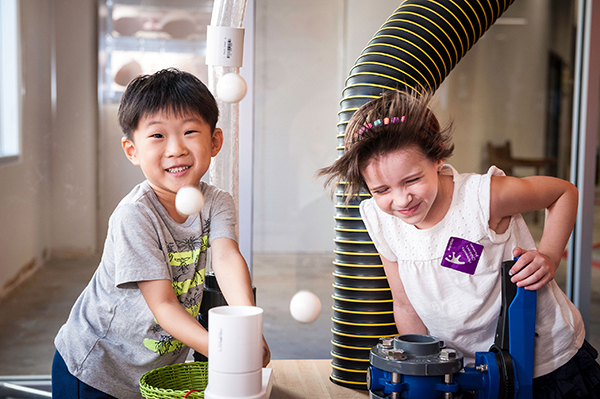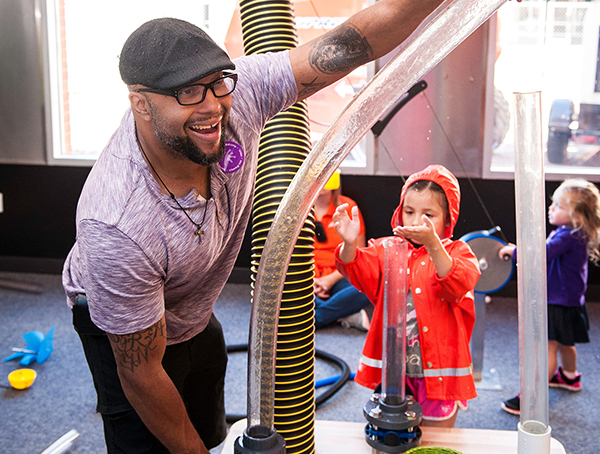PLAY IS UNIVERSAL—children all over the world play without any instruction, even in places of danger and deprivation. Nonhuman animals play, too.
“Play is about as ‘blueprinted’ a behavior as you can have in terms of basic survival and reproduction,” says professor Stephanie Carlson in the Institute of Child Development (ICD).
“By definition, play has no immediate purpose, and it can be construed as a waste of time. But the fact that it’s so universal has led us researchers to take it quite seriously.”
Scholars have been working to identify and explore play’s functions in human development for nearly a century. ICD is a national leader in that discovery.
Carlson and her colleagues and graduate students focus on the cognitive and social functions served by play, especially the development of executive function, commonly understood as the way we learn to control our behavior. In a new study, they documented a phenomenon they dubbed the “Batman effect”: In pretend play, children perform cognitively as if they are a full year older. Looking at something from a hero’s perspective, they tend to be more controlled and objective.
“Years ago the Russian psychologist Vygotsky said that when children play, they are ‘a head taller,’ and this study shows how that works,” says Carlson. “Even for adults, we know role-playing is important—practicing for real-world activities. Something has to be imaginable to become real.”
Play is the “work” of children, as Carlson describes it. Yet the push for more academics has impinged on recess and play of all sorts. Today’s children play an estimated eight hours less each week than children did just 30 years ago.
“I call it the war on play,” says Megan Gunnar, Regents Professor of Child Development and director of ICD. “Play gets contrasted with learning, and because we want children to learn more, we cut playtime. But by doing that, we remove a powerful pedagogical tool from our toolkit. Instead, smart educators learn to harness the power of play, teaching children concepts through guided play while children throw themselves wholeheartedly into the experience.”
Putting the research into practice
Gunnar was thrilled when, in 2011, the Minnesota Children’s Museum called. The award-winning museum, long dedicated to providing an environment full of play, was about to embark on an expansion at its St. Paul location.
“We’ve always been research based,” says museum president Dianne Krizan. “The expansion gave us a chance to step back and double down on our approach.”
The museum invited the University to become part of a research advisory committee that began to meet regularly. Carlson’s graduate student Rachel White—already an expert on pretend play—was drafted to write an accessible summary of research on all kinds of play and to spend time at the museum.
“I got to know the exhibits and the people putting them together,” says White, now an assistant professor of psychology at Hamilton College in New York. “What did they need? What would be beneficial for them to know?”
Barbara Hahn, the museum’s vice president for learning innovation, leads the team responsible for the exhibits and experience design. They developed the museum’s “7 Cs” to describe skills that children learn through play: creative and critical thinking, (self) control, confidence, collaboration, communication, and coordination.
“The research collaboration allowed us to think about the learning framework, to spend some time to develop the underpinning,” says Hahn. “For example, one area that wasn’t on our radar was Stephanie Carlson’s work on executive function, which became a proxy for ‘self-control’ in our seven Cs.”
When the museum reopens this June, it will have 10 new exhibits, including a maker space and a four-story climbing structure. It has always downplayed content in favor of play that supports developing skills, says Krizan, and that approach will be even stronger now.

Gunnar is glad the museum has been able to benefit from grounding its new exhibits in cutting-edge research. And she is excited about the work that the museum and research advisory committee are doing now—how to help adults support and extend children’s play experiences in the museum and after they go home.
Play is for grownups, too
Even though play comes naturally to most children, that doesn’t mean adults should be totally hands off. They can take a range of roles—onlooker, stage manager, co-player, or play leader.
“Helping to structure and guide children’s play helps to make it more effective,” says Carlson. She cites Playworks, a national nonprofit that provides different kinds of guided recess for schools, with success in keeping play fun and reducing harmful effects of conflict.
At the Minnesota Children’s Museum, before a six-month closure that began this winter to complete the expansion, visitors previewed a new exhibit that was ready to go. In Forces at Play, something unusual happened: lots of dads began jumping into play with their kids to experiment with the air launchers.
“It’s been really nice to see,” says Hahn. “One of our goals is creating a place comfortable for adults so they feel they can play, too.”

Learn more about the Institute of Child Development and the Minnesota Children’s Museum.
Story by Gayla Marty | Top photo by Erica Loeks Photography; others courtesy of Minnesota Children’s Museum | Spring/Summer 2017
 Children play on the climbing wall at the Shirley G. Moore Laboratory School.
Children play on the climbing wall at the Shirley G. Moore Laboratory School.